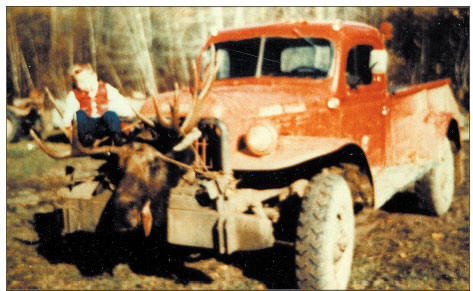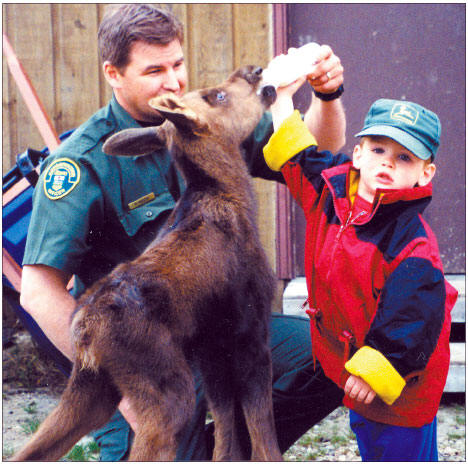|
A dying breed |
|
Steven Cross |
|
|
|
|
|
I have been in the game wardening business for 18 years now and as far back as I can remember I knew I wanted to be a Fish and Wildlife officer. I was exposed to some favourable and not so favourable impressions of Fish and Wildlife officers as a youth, but my passion continued. At about eight or so, I remember our current Director of Enforcement-Field Services checking my dad and I right after I shot a rabbit for trapline bait. I’m sure he knew exactly what was happening and made sure my father knew it too, but left it at that. Discretion is a huge part of our day to day enforcement tasks. I remember being impressed by the sharp uniform and the stunning green and white truck that were the icons of a Fish and Wildlife officer. My teachers were amazed by my attention level when Swan Hills Fish and Wildlife Officer Dennis Palkun attended my school for hunter education presentations. I grew up in a family that lived off the land and equally respected it. Our family had a guiding and outfitting business for 28 years and has held a Registered Fur Management Area (trapline) since 1975. My father was as straight as they come and continuously lectured my brothers and me on the rules. Our family has a genuine respect for Alberta’s valuable natural resources.
Photo of the author taken in 1970 or 1971 with a
bull moose taken by Last December I was asked to speak at the Alberta Professional Outfitters Society (APOS) convention in Edmonton. While speaking to many of the members, I learned that one of the common problems of the outfitting business is finding competent guides. Finding someone who has a strong back, a good head on their shoulders and some common sense in the bush is a hard model to find these days. This past June, High Prairie hosted the Alberta Trappers Association convention. My officers and I assisted the local chapter by bringing in the Report a Poacher trailer, display tables and flipping burgers for the Friday night barbeque. I loved the bumper stickers that the Fur Harvesters Auction from North Bay, Ontario gave out: “KIDS WHO HUNT, TRAP & FISH DON’T MUG LITTLE OLD LADIES”. That statement is not only funny, but very true. The unfortunate part of it is that the number of youths involved in hunting and trapping are diminishing. There wasn’t a lot of hair at the convention and that which was left was pretty grey! Hunter statistics have also shown a 43 per cent decline in Wildlife Certificate purchases in the last 25 years. The Fish and Wildlife Division continues to create incentives to entice youth hunters and after hitting rock bottom numbers in 1996/97, licence sales have increased about five per cent for the 2005/06 season. Hopefully, associations such as the Alberta Hunter Education Instructors Association, Alberta Professional Outfitters Society, Alberta Trappers Association, and Hunting for Tomorrow can continue to assist in promoting hunting and fishing to our youth. Currently, there are approximately 116 Fish and Wildlife officers in the field. We hired nine new officers about a year ago and one has since resigned. To whittle the numbers down to nine, approximately 250 people applied, 64 were interviewed. As it is with outfitters and trappers, it is becoming increasingly difficult to find people with the tools for the trade. I haven’t seen a video game yet that is focused on game warden skills. In the last month, four senior officers retired. Approximately 43 per cent of our officers will be eligible to go in the next five years. Even if we do find the money to replace those officers, will we find the quality people with the skills to do the job? The Fish and Wildlife Division has not had more than a handful of government funded wage positions in the last 10 years. Subsequently, we have not had the opportunity to train new officers or sort the wheat from the chaff. Sustainable Resource Development has recently hired a Successional Planner. I hope she comes with a magic wand.
District Fish and Wildlife Officer Steven Cross feeding an orphaned moose with his son Cole (and possibly the next generation of game warden). I was discussing this issue the other day with a member of the public who asked, “So are there fewer poachers now too and are they not as good at what they do because they lack the tools of the trade?” I was stumped. I didn’t take the time (because I don’t have the time) to research whether there has been an increase or decrease in violations over the past 10, 20 or 30 years, and I’m not sure what it would prove. From what I can see, it has pretty much run its course over my 18 years and I haven’t seen much of a change in the poaching trend. Are there less good guys to watch the same number of bad guys? Who is to blame for the declining numbers of game wardens to be? Is it the booming economy? Why go to college for four years to come out into a job that pays less than the starting wage in industry? I know I made more at 17 working in the oil field than when I started as a Fish and Wildlife officer at 21, after three years of college and three seasonal officer positions at minimum wage. Why do we do it? Maybe it’s a genetic defect, but I like to think that there are a select few of us that make it our responsibility to protect Alberta’s natural resources. Since being hired in 1989, my career has proven to be
everything I had hoped it would be. This year I was recognized as the
Alberta Fish and Wildlife Officer of the Year. This will likely be the
most rewarding achievement of my career. Game wardens are pretty much
accustomed to not receiving recognition for their dedication and
accomplishments. I usually compare it to being a referee; somebody’s not
going to like what you do. You get yelled at a lot, everybody knows
better and the pay stinks. But you know what? I love what I do and I’m
damn proud to do it!
Steven Cross
is
a
member
of
the
Alberta |
|

